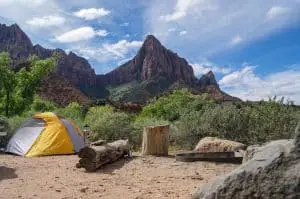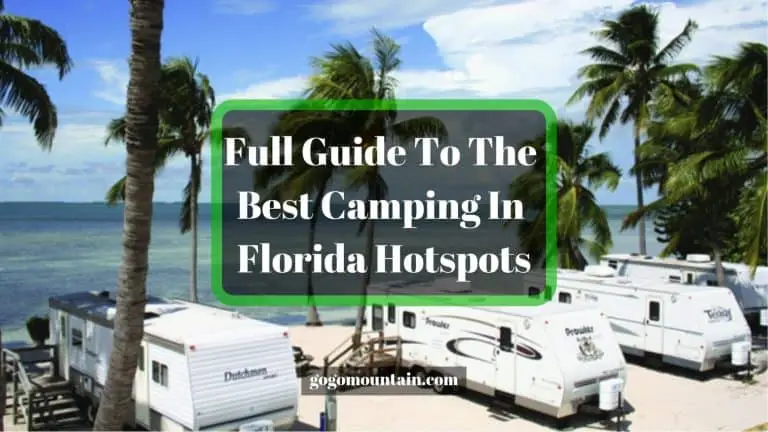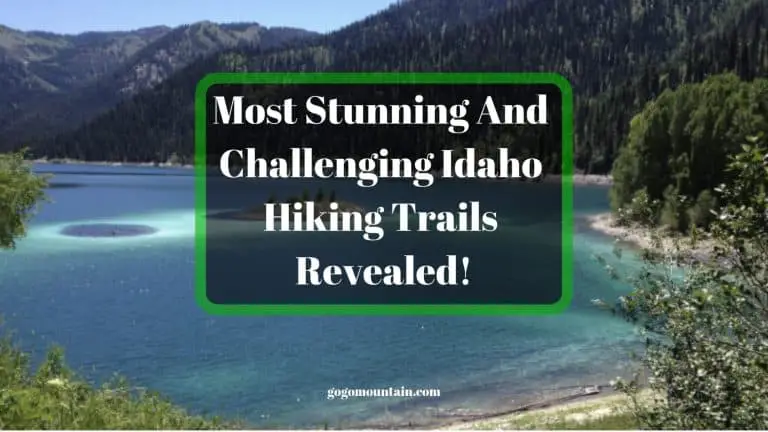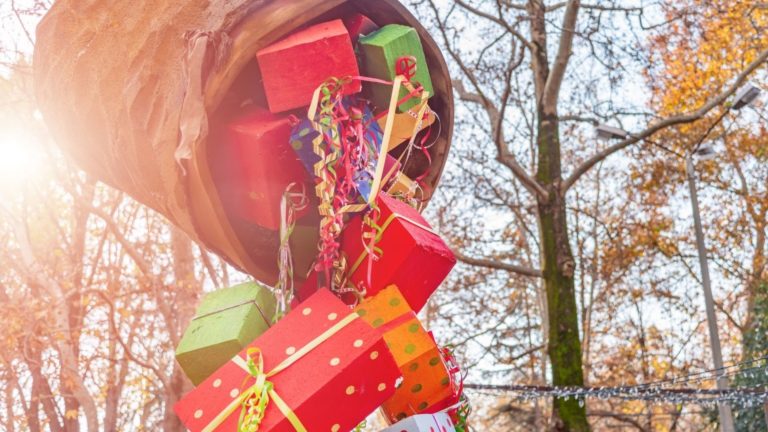6 BEST Summer Camping Tips + Gear to Stay Cool
We’ve put together a summer camping tips and tricks to help you enjoy your time on your trip.
From eating better on your trip, to avoiding crowds, this list will have you prepared to enjoy the peak outdoor season.
6 BEST Summer Camping Tips + 7 Gear to Stay Cool + Cooking Advice

[toc]
What do I need for summer camping?
Here are some essentials you will need to stay cool while camping in the summer.
1. Camping fan
If you’re wondering how to stay cool while camping, you will want to bring a camping fan.
Get a camping fan that doubles as a lantern. You can hang it in your tent at night.
2. Water carrier
Bring enough water in a water carrier. It keeps you hydrated and you can use it in a spray to cool you down.
Check out this section on the best water containers and how to keep drinks cold in our article, Camping Tips and Tricks.
3. Tent
You’ll need a good waterproof tent. We have reviewed the Best 4-Person Tents for the summer months.
However, if you’ve got a family of 4, you’ll want to choose a tent that’s bigger, like a 5 person or 6 person tent.
That will give you more room for your sleeping bags and in-tent gadgets and activities.
4. Cooler
This keeps your food cool. Have a Yeti for all your drinks.
Tip: If you can choose a campsite by the river, you can keep your cooler in the water to keep it cold.
5. Waterproof Tarp
In a pinch, you can hang the tarp to use as a sunshade.
You can also buy shade sails just for this purpose.
6. Be prepared for rain
Like any other season, you’ll want to be prepared for precipitation.
So wear waterproof shoes, pack extra socks and a large poncho that will cover you and your backpack.
7. Dress in layers
Layers are your friend in the outdoors to keep you comfortable.
Make sure your inner layers are moisture-wicking, as well as underwear. Most sports wear are moisture-wicking.
Summer Camping Tips
1. Eliminate Condensation in the Tent
Condensation is practically unavoidable – you need to breathe, after all! However, you can reduce condensation by maximizing airflow in the tent.
Simply crack one window or door at the top and crack another at the bottom. Hot air will rise and escape to the top while cool air will be pulled in via the lower vent.
Oh, and skip the rainfly on clear nights.
2. Adjust Your Water Filter
If your filter is failing to draw any water, consider turning the housing upside down. Then, try to pump again. This should do the trick.
If it doesn’t, you might have a dry or damaged O-ring. To remedy this, take the O-ring out of the piston and wide it down with a soft cloth. Depending on what you have with you, you can use silicone grease, lip balm, or even saliva to reinstate the seal.
3. Fix Your Tent’s Zipper
Tent zipper caught a snag? You can get it out, no problem. Simply work the fabric out by pulling it gently, making sure it remains parallel with the slider.
If this doesn’t work, try to move the slider repeatedly over the snagged area. Damaged zipper coils are often to blame, but bending them slowly back into shape by using a safety pin’s sharp end can help do the trick.
4. Always Have a Backup Plan
As much as you plan ahead, freak storms always have the ability to ruin your camping trip. Look up backup options, like trails that are in the rain shadow of a mountain’s peak, in case a storm strikes unexpectedly. You should also do your research by asking rangers about snow and water availability.
5. Crash on the Beach
Sleeping on the beach is one of the best summertime camping experiences you can have.
Just make sure you pick the perfect spot! You’ll want to camp in an area that is above the high-tide line, which is usually indicated by a line of debris washed up on shore.
Pitch your tent securely, ideally with guy lines around large rocks at every corner. You could also tie off your tent to stuff sacks filled with sand or sturdy branches.
Make sure the lines are buried about two feet deep at each corner, and secure them with a tautline hitch above the sand.
6. Stargaze Like an Astronomer
You don’t have to have a degree in astronomy to do so, though! All you need to do is camping spots that are far away from light pollution and smog – as well as those with low humidity – will be the best for viewing stars. Consider a spot like Natural Bridges National Monument or Big Bend National Park.
Cooking Tips for Camping in the Summer
What food should I bring for camping?
You should aim to pack about 3,500 calories for each day’s worth of food if you are planning on doing a lot of hiking.
Select calorie-dense options like protein bars, cheese, and peanut butter, which will help you cut down on weight without cutting out calories.
You can store every day’s meals in individual baggies. Ideally, you should pack no more than two pounds per person per day.
Your camping spice kit for outdoor meals
Camping food, especially MREs (meals ready to eat) or other freeze dried foods can sometimes be quite plain. Adding a bit of space can take things up a notch.
You can grab a compact camping spice set.
Or you can DIY your own camping spice kit. Pack spices in small plastic bottles, which will prevent clogging in the zippers you might find in bags.
Another option is to get backpacker’s salt & pepper shaker. They’re compact, sturdy, spill proof, and moisture proof.
The best spices to take with you? Consider bringing onion powder, Parmesan, dried mushrooms, sun-dried tomatoes, dried mushrooms, oregano, garlic, cayenne, pepper, and salt.
S’Mores Hack For Summer Camping Trips
Everybody loves s’mores, but if you’re looking for an exciting update to the bland classic, here’s an idea.
Simply soak your marshmallows in cognac for ten seconds, then place them in two Ziploc bags.
Roast marshmallows over a campfire and then add dark chocolate and two shortbread cookies for a sweet, savory treat.
How do you bake while camping?
Pizza in the wilderness sounds great, but hauling heavy cookware into the woods sounds terrible.
You can easily incorporate the “around the clock” method recommended by NOLS by stacking some rocks around a stove at the height of your burner.
Place a covered pot filled with dough on the burner, and place it so that a quarter of it is positioned over a low flame.
The rest should rest on the rocks. Rotate it a quarter turn every few minutes so a new section is covered. This will help your dough cook evenly and prevent it from burning.
How to pack an easy hot lunch
If a cold sandwich just won’t do the trick, heat things up by stashing a thermos filled with hot water in your bag.
At lunch, you can pour it over any dried meal, like a soup or macaroni.
Cheese that doesn’t need refrigeration
The best cheese for summer camping are the ones that don’t need refrigeration. Your options are hard or semi-hard cheese.
These types of cheeses usually lasting for about a week in moderate conditions. Consider bringing cheeses like Gouda, Swiss, Parmesan or Jarlsberg.
Softer cheese with more natural oils, like Brie and cheddar, will last only a day or two. Opt for waxed wheels or bricks, as these last longer than slices or blocks.
As with other foods, remember that warm temperatures and hot sunlight increase the rate of spoilage.
You can pack your cheese in zippered bags and stash it in the middle of the backpack, which will protect it and insulate it on hot days.
Making wild camping food
An activity that you can often get away with while camping in the summer is harvesting wild patches of raspberries, blueberries, or huckleberries, you can make your own wild berry compote.
If you know wild berries, or are traveling with someone who does. You won’t want to accidentally pick up poisonous berries to eat.
A simple recipe for wild berries is to toss a couple of handfuls into a bottle and then add sugar. Then, let the mixture sit overnight and a syrup will form.
Heating the berries will break it down and takes about two minutes. You can serve this delicious mixture over pancakes or oatmeal as a delicious breakfast.
Camping Mistakes to Avoid
It’s easy to forget gear.
Even veteran wilderness experts forget things from time to time. Prevent this by printing a packing list ahead of time, and cross of each item as you load or pack it.
Get a Permit
It’s not uncommon to miss out on reservations for the top campsites. However, this doesn’t mean you have to stay home. Instead, here are a few alternative options.
Phone the backcountry office. Some parks reserve a portion of campsites or permits for walk-ins. Determine when and how they are distributed, and show up early with alternatives if needed.
Rough it. Instead of camping in an established area, backpack into a wilder area. These are often overlooked by less serious campers, and as long as you aren’t violating any laws or regulations that are in place in that area, you will enjoy a great new camping spot in return.
How to Choose the Perfect Summer Camping Spot
Try to camp in an already-established campsite to reduce wilderness impact. If this is not possible, camp about 200 feet from a lake or stream. You will want to set up camp on a hard surface like a slickrock, gravel bar, forest duff, or sandy beach. Avoid grassy meadows or alpine tundra, as the plants here are extremely vulnerable to damage from foot traffic.
1. Watch out for widowmakers.
A widowmaker is a tree branch that has the potential to cause some serious damage when it falls. The branches that you need to watch out for when selecting your campsite include those that are old, dead, or suspended precariously over your potential site. You should also avoid rockfall zones. Either of these can become deadly in a hurry.
2. Avoid wet areas.
Try not to camp in shallow depressions where rain will be more likely to gather. Instead, set up your tent on level surfaces where rain can run off instead.
3. Avoid dangerous plants.
Take the time before your trip to familiarize yourself with the signs of toxic plants, and don’t set up camp anywhere near poison oak, sumac, or ivy.
If you make contact with them by mistake, you have roughly ten minutes to get the oily resin, urushiol, off your skin. After that time has passed, the oil will bind to your skin and cause an itchy rash several days or a week later.
To get rid of urushiol, wash your skin with biodegradable soap and warm water.
Use an alcohol pad to remove every last trace of the oil. Once you return home, wash everything, keeping in mind that urushiol can remain on clothing, camping equipment – and even your dog!- for up to a year later.
Related Posts:
Top 5 Kayaks for Camping and Fishing
Best Men’s Backpacking Boots
Best Campsites by State
4 BEST Generators for Camping












